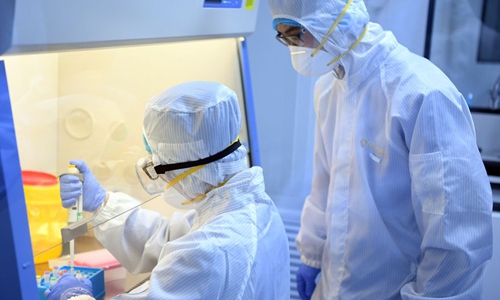HOME >> CHINA
Coronavirus found in patients’ urine poses challenge to China’s sewer system: expert
By Liu Caiyu Source:Global Times Published: 2020/2/22 17:14:18

Researchers subpackage 2019-nCoV detection reagents at a company in Wuqing District, north China's Tianjin Municipality, Jan. 27, 2020. Photo:Xinhua
In another breakthrough, Chinese scientists have identified traces of coronavirus in patients' urine, suggesting the virus is capable of traveling with the blood to the human body to harm multiple organs. The virus in urine also poses a challenge to China's sewer system amid the epidemic outbreak.
The latest finding by top epidemiologist Zhong Nanshan's team sheds light on the transmission and prevention of the epidemic, another breakthrough after scientists found isolated novel coronavirus strains from samples of infected patients' feces.
Strains isolated from feces and urine pose a threat to China's sewer system, especially in hospitals, where swarms of patients are admitted. If the patients' feces and urine are not handled properly, it can contaminate the air and transmit through aerosols, Yang Zhanqiu, the deputy director of the pathogen biology department at Wuhan University warned.
"But we don't have to overreact to it. No need to disinfect the sewage systems in the whole city, as large amount of disinfectant may cause long-term water pollution," Yang told the Global Times Saturday.
Besides feces, the detection of strains in urine possibly means the virus could flow with the blood in the body and harm multiple organs; not only lungs but kidneys and heart, Yang said.
Transmissions through respiratory routes and contact, however, remain the major sources of the novel coronavirus contagion, experts said.
Zhong has stressed the importance of city sewer systems in the fight against the coronavirus, citing the case of Amoy Gardens in Hong Kong during the SARS crisis in 2003.
During the SARS outbreak in 2003, aerosolized feces spread from floor to floor through plumbing in the Amoy Gardens residential complex in Hong Kong, infecting over 300 people with the virus, according to media reports.
Statistics show since the disinfection of drainage and sewage treatment facilities was launched on January 29 in Wuhan, the city had dispatched 6,520 personnel and used 1,963.58 tons of disinfectants as of Tuesday, the Xinhua News Agency reported.
Posted in: SOCIETY